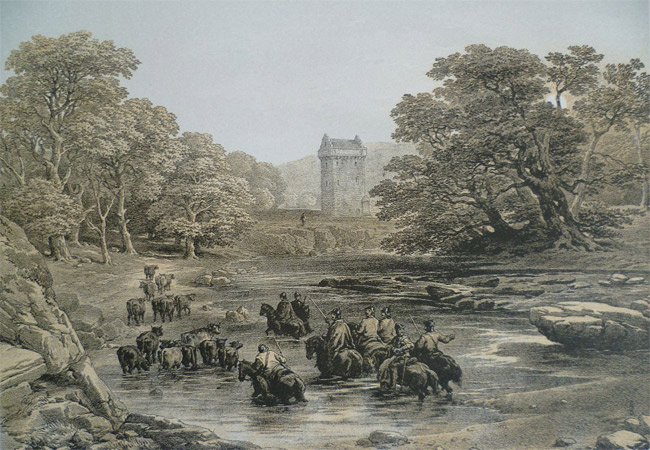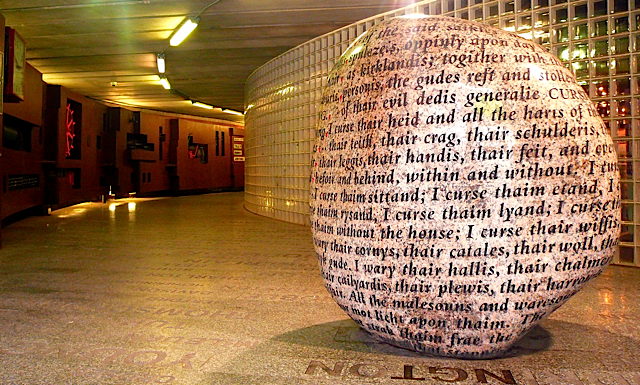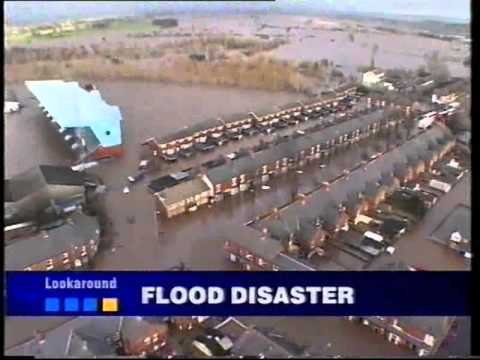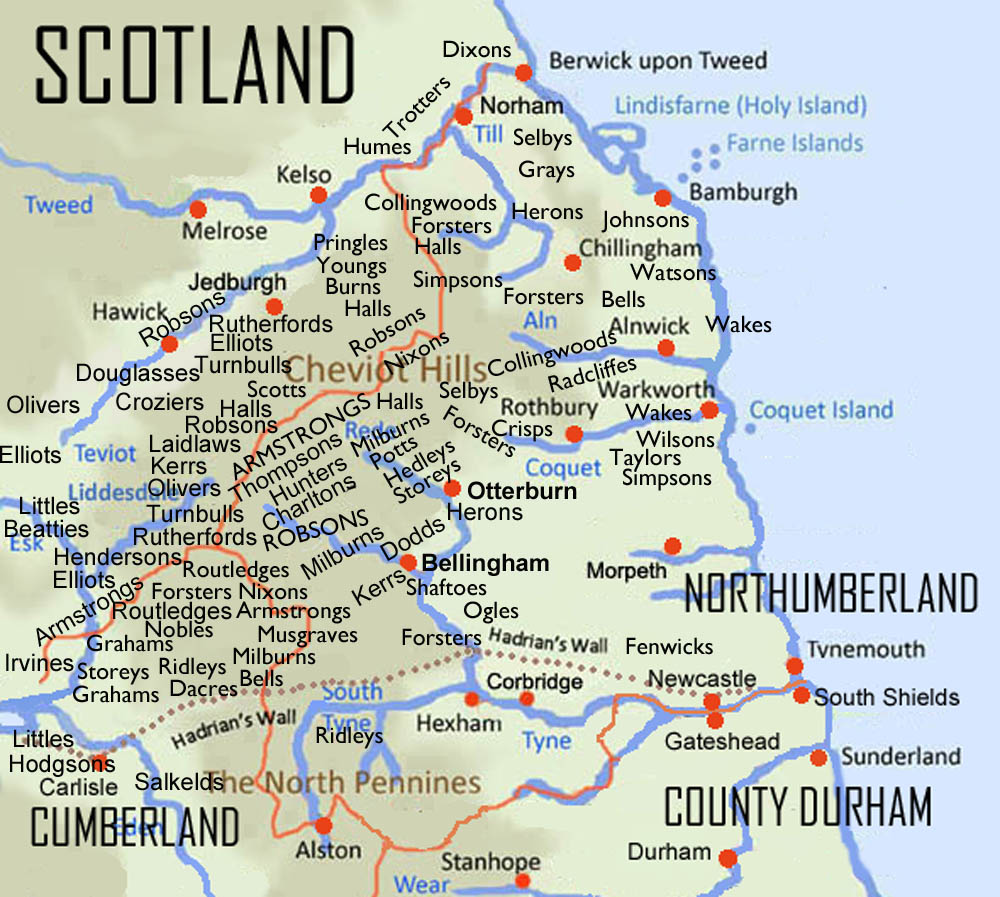Border reivers were raiders along the Anglo-Scottish border from the late 13th century to the beginning of the 17th century. These were rugged, tough people who enforced their own brutal code of conduct in what was to be known as the 300 Year War.
There are 77 predominant family names who can claim to have been Reivers, names like Armstrong, Robson, Douglas, Elliot, Dodd, Graham and Bell among them (see full list at the bottom of the page). The conflict wasn’t Scotland against England, it was between the families themselves. The Border families aligned themselves with neither the English or Scottish Crown it was all about kinship – they aligned themselves with those of the same name. These were hard, brutal times, the Border people lived on a permanent battleground, raiding and marauding was the only way to survive.

The Borders were difficult to control, this was a lawless land, the Reivers were notorious. The church held little influence here neither did the monarchs. It was seen as a time of complete moral collapse, so much so that the Archbishop of Glasgow took it upon himself to excommunicate the Border thieves.
Gavin Dunbar the Archbishop of Glasgow, issued a dire warning to Reivers of the Scottish Marches in the form of what is known now as the ‘Monition of Cursing’. This Cursing damned the Reivers to eternal suffering in the fires of Hell unless they returned to Holy Mother Church, put away their unholy lives and conformed to the laws of the Church and the Land.
It is a tirade which runs to 1500 words and was to be read out in all the churches in the Scottish Borders, at least those that still existed! Not that the Reivers would be present to hear the condemnations levelled against them!
The curse was ordered to be read from every pulpit in the diocese and be circulated throughout the length and breadth of the Borders.
The Curse Against the Reivers
Here is a small piece of the epic curse:
‘I curse thair heid (head) and all the haris (hairs) of thair heid; I curse thair face, thair ene (eyes), thair mouth, thair nose, thair tongue, thair teith, thair crag (chin), thair schuderis (shoulders), thair breast, thair hert, thair stomok, thair bak, thair armes, thair leggis, thair handis, thair feit, and everilk (every) part of thair body, frae the top of thair heid to the soill of thair feit, befoir and behind, within and without.’
‘… I curse thaim etand (eating), I curse thaim drinkand (drinking), I curse thaim walkand (walking), I curse thaim sleepand( sleeping)… I curse thair wiffis (wives), thair barnis ( bairns i.e. children) … thair cornys, thair catales, thair woll (wool), thair scheip (sheep), thair horse… thair barnys (barns)… thair plewis (ploughs)…that is necessair for thair sustentatioun(sustenance) and weilfair (welfare).
…And finally, I condemn thaim perpetualie to the deip pit of hell, to remain with Lucifer and all his fallowis, and thair bodeis to the gallowis of the Burrow Mure, first to be hangit, syne revin and ruggit with doggis, swyne and utheris wyld beists… (Ripped apart by beasts on the Boroughmuir, Edinburgh and other places of execution).
The Reivers’ Response
Such a curse from the church may have had some effect in an earlier period, but at this time it was just laughed at, if anything between the year of 1525, and the close of the 16th century the crime accelerated out of any control. A threat of eternal damnation meant little to the Reivers at a time when other men lived in awe of the Church and its promise of a happy afterlife if its dictates were followed. They ignored the Monition of Cursing and followed the old way. To most it was the only life they knew. Future paradise or future damnation? What was the difference? Neither filled a stomach and the present was hell on earth anyway.
It was not until the unification of the Crowns of Scotland and England after the death of Elizabeth I in 1603, that the final solution was enacted. The new King of the unified country; James I of England and VI of Scotland, took up residence in London. He resolved to manage the country as one, and it was no longer acceptable to allow the reivers free reign of the borders with near impunity. The so called ‘pacification of the borders’ was simply resolved by the summary execution or deportation of the offenders en masse. Not many people know about The Clearances of The Borders. By about 1610, the ‘broken men of the borders’ were finally broken themselves. Although occasional feuds and acts of criminality continued to occur, the business was less endemic and the law became more effective in dealing with perpetrators.
Reivers Cursed Before 1525
It was not the first time that a Curse had been put upon the Reivers. In 1498 Richard Fox, Bishop of Durham denounced the Reivers of Tynedale in Northumberland, England and forbade any priest to minister to them.
In 1524 the Tynedale Reivers were cursed yet again; this time by no less than Cardinal Wolsey. At Easter in that year Hector Charlton of the Bower raided Bellingham church, broke into the tabernacle and stole the Communion hosts. He also made away with a firkin of wine. At Tarset Hall Charlton served the Reiver congregation with wine and received the offerings due to the absent minister.
In the year 2000 a stone commemorating the Monition of Cursing was erected in Carlisle, Cumbria near to the formidable pile that is Carlisle castle. The Great Border city is justly proud of its association with the Border Reivers. It seemed a fitting addition to a region which is rightly proud of its heritage from the Roman Occupation to the present day.

But residents in Carlisle claim the stone has brought them disasters from disease to the relegation of the local football team.
In 2005 Carlisle was overtaken by floods of an unprecedented level. Houses were swamped to their upper floors as the river Eden burst its banks and engulfed everything in its path. Vast swathes of the city were underwater for days; houses on the flood plain of the river seriously damaged. Many had to leave their homes and find shelter elsewhere for up to and over a year before they could return. It was an extremely harrowing episode in the history of this proud northern place just south of the Border with Scotland.

Also only weeks after the oval-shaped stone was installed, foot and mouth saw one half of Cumbria’s livestock burning on funeral pyres, followed by a succession of factory closures and relegation for Carlisle United.
The curse was taken so seriously that a Council member proposed the removal of the stone.
The city council took advice from local Christian groups, including the Bishop of Carlisle and a blessing was included within the artwork taken from The Bible, Philippians 4 Verse 6 to try and counteract the curse.
Border Family Names

Archbold
Beattie(son)
Blenkinsop
Bromfield
Bunyan
Burn
Carlisle
Carnaby
Carr
Cessford
Charlton
Collingwood
Coulter
Craw
Cresswell
Crozier
Curwen
Dacre
Dixon
Dodds
Dunne
Etherington
Fenwick
Forster
Gilchrist
Goodfellow
Hall
Halliday
Harden
Hedley
Hetherington
Hodgson
Jamieson
Kilpatrick
Laidlaw
Lowther
Milburn
Musgrave
Nixon
Noble
Ogle
Oliver
Orde
Percy
Potts
Reaveley
Redpath
Reed
Ridley
Robson
Rowell
Routledge
Salkeld
Selby
Shaftoe
Stamper
Stephenson
Storey
Tweedie
Veitch
Witherington
Waddington
Wilson
Yarrow

My brothers and I are planning a trip to Scotland in June 2019 and are trying to get all the family history that we can. If there is anything that you could help us with, would definately be appreciated. We found Robert Rutherford came to America in the late 1600 or early 1700
That sounds like a great trip! Have a great time!
Did you and your brothers make the trip to Scotland? What did you find in Rutherford related heritage?
I will visiting my ancestral lands this June, 2018. Are there any sites of Johnstone importance I should visit besides Lochwood Tower? Do you think it would be possible to meet the Earl of Annandale and Hartfel?
This history is really awesome. Thanks very much. Can’t wait to read more. My ancestor David Murray b 1777 came from Mennock in Dumfries.
My ancestors came from Dumfries, River Tweed, Ford, Northumbweland areas as well! I was born a Swan my mother being a Bell. Other family names in my tree are Patterson, Burrell, Coburn, Simmons, Hamilton,Russell, Taylor. Im, on Ancestory and have my DNA back from there just trying to fill in some of the blanks. Any recommendations of where to look online or in Scotland would be great! Thank you
My family Immigrated to Canada in the late 1800’s
Hello,
I have just started looking into my fathers heritage being in the US I am finding it most difficult.
My Grand Father was John Miles Hensley, I was told that our name Hensley is derived from Ainsley.
Can you offer any help in my search.
While on a visit to Scotland, I learned that the Grahams had befriended a witch. I cannot remember her name. I believe her first name was Kate. Could you tell me what her name was? Thank you.
This sort of thing doesn’t bother me as much as I thought it might, I have an open mind and accept it for what it is.
They are the words of another type of desperate man, trying so hard to control desperate men (for whatever reason) with the threat of damnation.
My only real fear nowadays is what must other people think, and how are they effected by it!
I suppose it goes down in history just the same as all the other wrong doings done by all the other desperate people from peasant to royalty and holy men.
Border dwellers suffered a hard time from both sides both militarily and religiously.
I have sympathy for all border dwellers globally and see they do have a problem. It’s not easy having to stay neutral.
It’s not as easy as “are you in or out”!
That’s my opinion today anyway.
It is being a dang Armstrong or even one of those Elliott. It is said someone visited the borders and knock on the door, and asked, “are there any Christians?”, the reply was,”no we’s Armstrong and Elliot”. https://elwald.com/peace-on-the-border/
I also now think that someone kind should take the said curse and put on a show of forgiveness (maybe at that stone) to those family members or name carriers of today that don’t even have a clue what some people might be going on about!!
It just might save some people unjustified persecution even in the 21st century. I assume we’ve all cooled down by now.
We go a long way to protect others so why not!
In fact I think we should insist! The normal 10 commandments is enough wouldn’t you say.
Anything else today is insulting to say the least.
As shameless atheist this curse is a blessing.
Whenever god-botherers come knocking on my door it’s great to see their expression when I explain that my family were so evil that they were cast out of the church forever and that we’re all cursed for all eternity. Me and the kids are beyond redemption already thanks – bye!
Perhaps you profess to already being a Christian and think you’ll get into Heaven on that account?
Apparently not; Peter’s going to whip out his flaming sword regardless and we’re all going DOWN!
Damned if you do, Damned if you don’t..
My Husbands Family Crawford Originally came from Scotland but dont know from where Earliest Ancestor I have is John Crawford born 1671 Heightington Darlington I dont see Crawford in the Border names so maybe they were not Borderers ?
but another relative in my own family is John Redpath born 1748 married Jane Soper evidently born Scotland (he had Brother Chruistopher Born 1750) Family says from Earlston area ,the family settled by 1800s in St Alphange Greenwich Kent
any information would be welcome if my Redpaths were involved in as Borderers thank you
regards Rae Crawford
Just found out I’m A: Scottish, B: from Clan Kinnimont, and C: cursed. Well at least my family isn’t boring XD
Honestly though, this is super interesting! Thank you for posting!
Yes, I think we should try and get this curse revoked!
Fascinating. I have distant Trotter ancestors on my maternal side. My 6th great grandmother was a Trotter. I can trace her back three generations to Trotter’s in Scotland.
My grand parenjts came from dumfries and finished up in glasgow
Hi,
Am trying to trace some areas to look for regards my grandmothers line of Scott’s, they were closely linked with the Watsons notably of the school in Edinburgh and again with the Ogilvies, my late great aunt “Dettie” Ogilvie lived in a very large house in Perth with full retinue of in service staff and her daughter Bertha Ogilvie. She was titled but have failed to discover her titles but she was fabulously wealthy too and counted amongst her friends the Dowager of Alyth. Her beautiful house is now part of a large hotel complex in Perth but I cannot seem to find it on the maps 🙁
Leonard Scott, my grandmother’s father was a teacher and my late grandmother had a curious name of Dorothy Jean Watson Scott whilst my great aunt Phyllis herself a teacher of some repute was named Phyllis Leonard Scott. Its ironic in that my grandmother married a Walter Watson so she became a Watson-Watson.
I bear the Scott name as have all members of the Edinburgh (Morningside) Watsons in the eldest male child, I know too my great great great grandmother founded many schools in the north of Scotland finishing her years in Tongue as schoolmistress.
Am planning to visit George Watson’s who kindly traced the school photo’s of my aunt and grandmother and some other related Watson’s hailing from Aberdeen area, I know from visiting graves in Fortingull and Aberfeldy I have Naughton and McNaughton’s ancestors buried there and allegedly once upon a time a branch of our family owned the lands around Glen Lyon with the last member reduced to being the castle’s gamekeeper there.
Years ago I had a most interesting find too, former Prime Minister Cameron had an elderly relative in the care home I worked for and she had a full family tree on her wall done by his wife for her as she loved it all, to the right of the Cameron’s was the links to my part of the family and I had happy memories of pointing out to my distant cousin that I was the Ian Watson shown at the extremes of her family tree. The PM however was very disinterested but his wife thought it amazing and I put her in touch with my grandparents who had done a lot but sadly the research was lost after their passing.
I apologize but I am new to this. From what I have been able to trace, my 10th great-grandfather was Sir Patrick Maxwell of Springkel. I believe he was the 1st Baronet.
Hi I am also a Watson but only known in the northeast of Los Angeles. As I lived their for 45 years, A small town named Highland Park.My grand father worked for the ( no longer exist) M.G.M. Movie studios and won some recognition as a sound technition for his work on the movie musical Oklahoma, and his efforts on helping to develop technicolor.He was known around the studio as pops;Watson.And for the Watsons out there in the World of Scots/Irish decent,The Watsons have a clan Watson.And our Clan lands are on the north side of the Firth of Forth.Thanks, Glenn Watson.